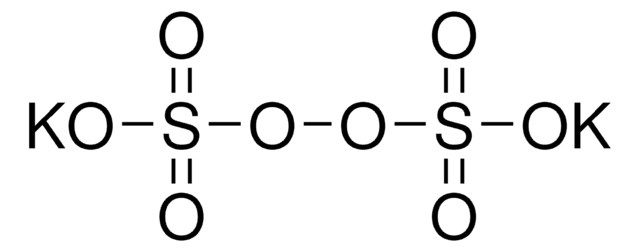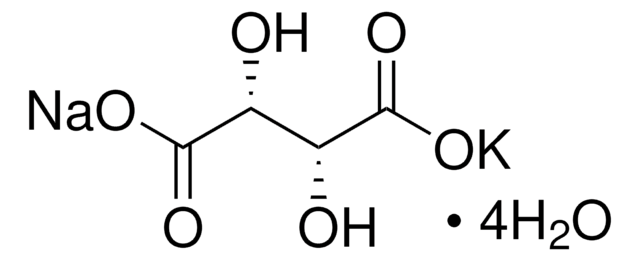799343
Sodium metabisulfite
anhydrous, free-flowing, Redi-Dri™, ReagentPlus®, ≥99%
Synonym(s):
Sodium disulfite, Sodium pyrosulfite
About This Item
Recommended Products
grade
anhydrous
Quality Level
product line
ReagentPlus®
Redi-Dri™
Assay
≥99%
form
powder
quality
free-flowing
mp
>300 °C (lit.)
SMILES string
[Na+].[Na+].[O-]S(=O)S([O-])(=O)=O
InChI
1S/2Na.H2O5S2/c;;1-6(2)7(3,4)5/h;;(H,1,2)(H,3,4,5)/q2*+1;/p-2
InChI key
HRZFUMHJMZEROT-UHFFFAOYSA-L
Looking for similar products? Visit Product Comparison Guide
General description
Features and Benefits
- Increased efficiency – Eliminate time and effort of loosening hardened powders
- Safety – Avoid risks of using tools of force to break up clumps
- Economy – Faster preparation and solvation increase productivity and reduce costs
- Assured quality – Excellent, expert-tested quality with no anti-caking agents
- Flexible volumes – Available from research amounts to scale-up quantities
Other Notes
Legal Information
Signal Word
Danger
Hazard Statements
Precautionary Statements
Hazard Classifications
Acute Tox. 4 Oral - Eye Dam. 1
Supplementary Hazards
Storage Class Code
11 - Combustible Solids
WGK
WGK 1
Flash Point(F)
Not applicable
Flash Point(C)
Not applicable
Certificates of Analysis (COA)
Search for Certificates of Analysis (COA) by entering the products Lot/Batch Number. Lot and Batch Numbers can be found on a product’s label following the words ‘Lot’ or ‘Batch’.
Already Own This Product?
Find documentation for the products that you have recently purchased in the Document Library.
Customers Also Viewed
Our team of scientists has experience in all areas of research including Life Science, Material Science, Chemical Synthesis, Chromatography, Analytical and many others.
Contact Technical Service








